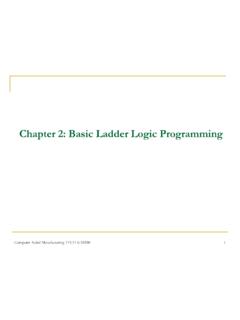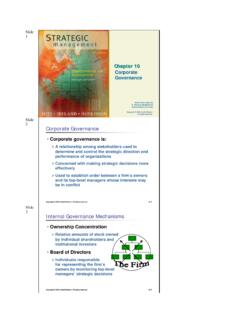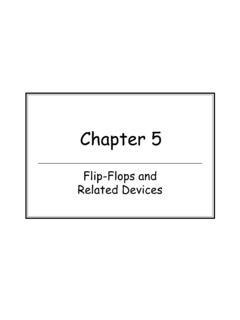Transcription of Chapter 5: Computer Systems Organization
1 Chapter 5: Computer Systems Organization Invitation to Computer Science, C++ Version, Third Edition Objectives In this Chapter , you will learn about: The components of a Computer system Putting all the pieces together the Von Neumann architecture The future: non-Von Neumann architectures Invitation to Computer Science, C++ Version, Third Edition 2. Introduction Computer Organization examines the Computer as a collection of interacting functional units . Functional units may be built out of the circuits already studied Higher level of abstraction assists in understanding by reducing complexity Invitation to Computer Science, C++ Version, Third Edition 3.
2 Figure The Concept of Abstraction Invitation to Computer Science, C++ Version, Third Edition 4. The Components of a Computer system Von Neumann architecture has four functional units: Memory Input/Output Arithmetic/Logic unit Control unit Sequential execution of instructions Stored program concept Invitation to Computer Science, C++ Version, Third Edition 5. Figure Components of the Von Neumann Architecture Invitation to Computer Science, C++ Version, Third Edition 6. Memory and Cache Information stored and fetched from memory subsystem Random Access Memory maps addresses to memory locations Cache memory keeps values currently in use in faster memory to speed access times Invitation to Computer Science, C++ Version, Third Edition 7.
3 Memory and Cache (continued). RAM (Random Access Memory). Memory made of addressable cells . Current standard cell size is 8 bits All memory cells accessed in equal time Memory address Unsigned binary number N long Address space is then 2N cells Invitation to Computer Science, C++ Version, Third Edition 8. Figure Structure of Random Access Memory Invitation to Computer Science, C++ Version, Third Edition 9. Memory and Cache (continued). Parts of the memory subsystem Fetch/store controller Fetch: retrieve a value from memory Store: store a value into memory Memory address register (MAR).
4 Memory data register (MDR). Memory cells, with decoder(s) to select individual cells Invitation to Computer Science, C++ Version, Third Edition 10. Memory and Cache (continued). Fetch operation The address of the desired memory cell is moved into the MAR. Fetch/store controller signals a fetch, accessing the memory cell The value at the MAR's location flows into the MDR. Invitation to Computer Science, C++ Version, Third Edition 11. Memory and Cache (continued). Store operation The address of the cell where the value should go is placed in the MAR.
5 The new value is placed in the MDR. Fetch/store controller signals a store, copying the MDR's value into the desired cell Invitation to Computer Science, C++ Version, Third Edition 12. Memory and Cache (continued). Memory register Very fast memory location Given a name, not an address Serves some special purpose Modern computers have dozens or hundreds of registers Invitation to Computer Science, C++ Version, Third Edition 13. Figure Overall RAM Organization Invitation to Computer Science, C++ Version, Third Edition 14.
6 Cache Memory Memory access is much slower than processing time Faster memory is too expensive to use for all memory cells Locality principle Once a value is used, it is likely to be used again Small size, fast memory just for values currently in use speeds computing time Invitation to Computer Science, C++ Version, Third Edition 15. Input/Output and Mass storage Communication with outside world and external data storage Human interfaces: monitor, keyboard, mouse Archival storage : not dependent on constant power External devices vary tremendously from each other Invitation to Computer Science, C++ Version, Third Edition 16.
7 Input/Output and Mass storage (continued). Volatile storage Information disappears when the power is turned off Example: RAM. Nonvolatile storage Information does not disappear when the power is turned off Example: mass storage devices such as disks and tapes Invitation to Computer Science, C++ Version, Third Edition 17. Input/Output and Mass storage (continued). Mass storage devices Direct access storage device Hard drive, CD-ROM, DVD, etc. Uses its own addressing scheme to access data Sequential access storage device Tape drive, etc.
8 Stores data sequentially Used for backup storage these days Invitation to Computer Science, C++ Version, Third Edition 18. Input/Output and Mass storage (continued). Direct access storage devices Data stored on a spinning disk Disk divided into concentric rings (sectors). Read/write head moves from one ring to another while disk spins Access time depends on: Time to move head to correct sector Time for sector to spin to data location Invitation to Computer Science, C++ Version, Third Edition 19. Figure Overall Organization of a Typical Disk Invitation to Computer Science, C++ Version, Third Edition 20.
9 Input/Output and Mass storage (continued). I/O controller Intermediary between central processor and I/O. devices Processor sends request and data, then goes on with its work I/O controller interrupts processor when request is complete Invitation to Computer Science, C++ Version, Third Edition 21. Figure Organization of an I/O Controller Invitation to Computer Science, C++ Version, Third Edition 22. The Arithmetic/Logic Unit Actual computations are performed Primitive operation circuits Arithmetic (ADD, etc.). Comparison (CE, etc.)
10 Logic (AND, etc.). Data inputs and results stored in registers Multiplexor selects desired output Invitation to Computer Science, C++ Version, Third Edition 23. The Arithmetic/Logic Unit (continued). ALU process Values for operations copied into ALU's input register locations All circuits compute results for those inputs Multiplexor selects the one desired result from all values Result value copied to desired result register Invitation to Computer Science, C++ Version, Third Edition 24. Figure Using a Multiplexor Circuit to Select the Proper ALU Result Invitation to Computer Science, C++ Version, Third Edition 25.











